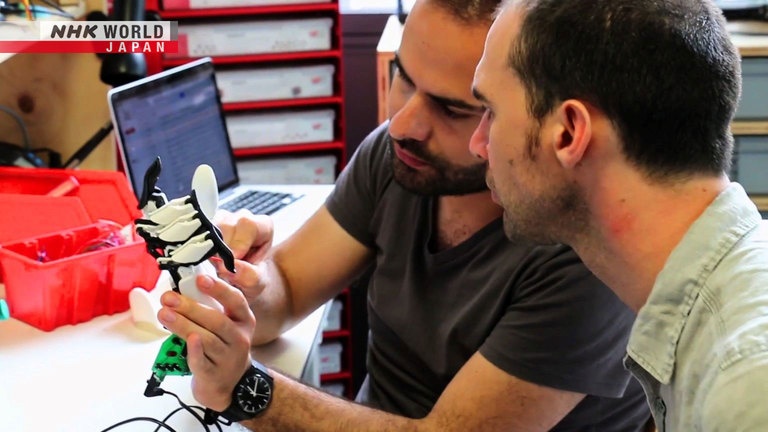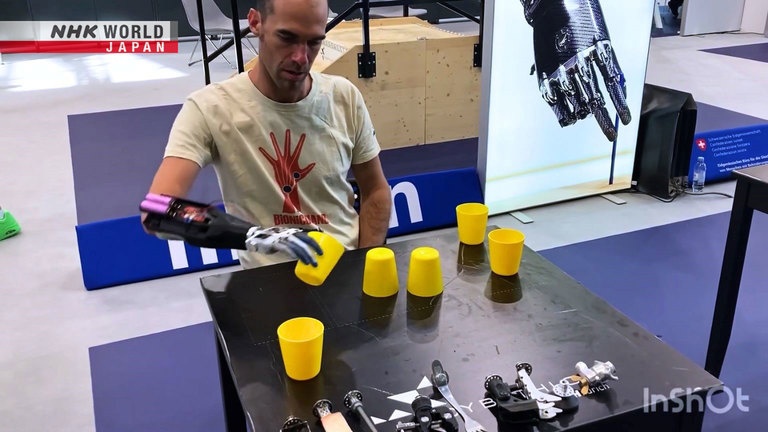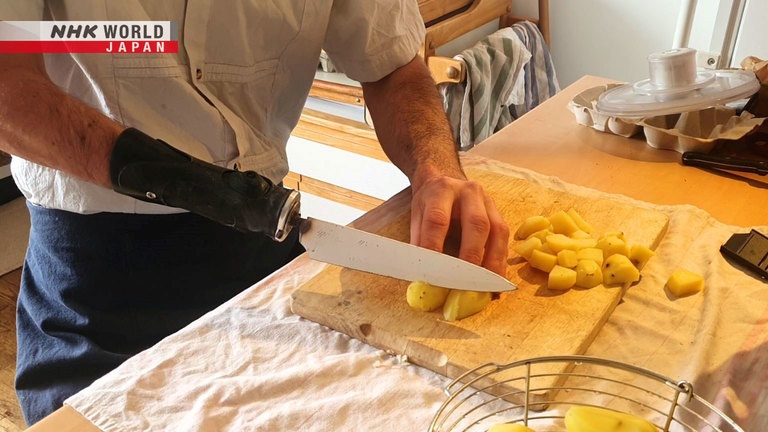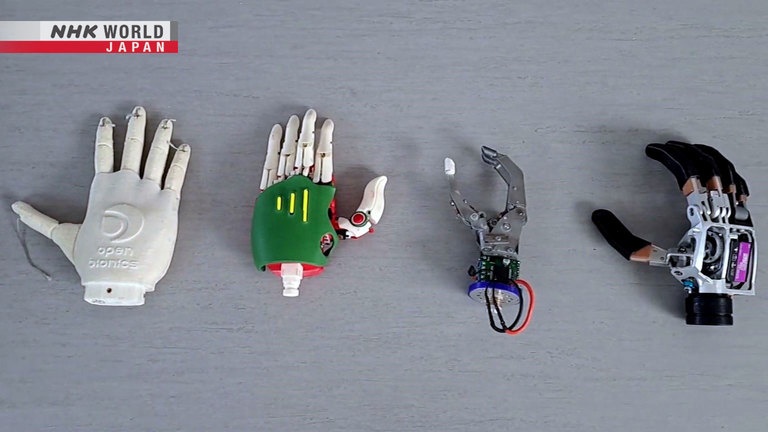Transforming Limitations Into Motivation: Nicolas Huchet / Founder of My Human Kit
We feature an engineer who is changing the world for people with disabilities like himself by making the blueprints of myoelectric prosthetic hands accessible to everybody on the Internet for free.




Transcript
Direct Talk
For the past 10 years,
Nicolas Huchet has been undertaking
an unprecedented "Industrial Revolution"
through his innovative approaches.
His unique destiny begins at the age of 18
when he accidentally lost his right hand.
Using digital Fab Lab technology,
a team of enthusiasts, and a 3D printer,
he manufactures his own prosthesis,
the Bionico Hand.
Through this process, he pioneers
a new concept of creating objects,
unique and accessible to all.
His discovery experiences phenomenal success,
taking him around the world,
and into the spotlight.
Today, I realize that
if I hadn't lost my hand,
I would be less happy.
In the field of prosthetics,
it's an industrial revolution
that blends high-tech and low-tech,
meeting a significant demand.
Immediate sharing of open-source plans
enables rapid evolution
and proposes a new economic model,
paving the way for autonomy.
Nicolas establishes the organization
My Human Kit
and its Humanlab, a participatory Fab Lab
dedicated to disabilities.
Those affected are
at the heart of the projects,
creating social connections through sharing.
Weaving connections worldwide,
Nicolas spreads his message:
transforming limitations into motivation.
At 18, I had been working in
industrial mechanics for two years.
I was employed in a
metallurgy company as a worker
when I had a work-related accident
with a bending press, a hydraulic press.
I had my hand amputated.
A week after the amputation,
I found myself in a rehabilitation center
to learn how to use a myoelectric prosthesis.
It's an electric hand controlled by muscles,
and I was shown a video,
and in reality, the hand did this.
It wasn't that.
It was a difficult moment,
a huge disappointment.
Indeed, the prosthetic provided
by the medical establishment,
shaped like a claw,
hidden beneath a plastic glove,
in fact, has very limited functionalities.
For the following 10 years,
Nicolas lived with these new constraints.
And when newer, more sophisticated
prosthetics finally emerge,
he had a renewed sense of hope.
I contacted the manufacturer in England,
who sent me a quote for about €30,000.
I was very frustrated,
very angry because I didn't have that amount,
and I realized that without money,
you can't do anything.
It was a stark reminder because
I come from a very modest background.
At the same time,
Fab Labs were emerging in France.
This global network, initiated by
the Massachusetts Institute of Technology,
comprised digital laboratories offering
free access to 3D printing technologies
and open-source software.
By chance, Nicolas meets
the teams from the Rennes Fab Lab
who take an interest in his disability.
We searched for a hand
and found a robotic hand
in an amateur video
demonstrating its functionality.
There was a man pressing keys on his
computer keyboard, making the hand move.
At that moment, I thought,
"That's it, I'm going to do it."
They made me understand that
if I came to the Fab Lab,
they would help me make the robotic hand.
But in exchange for their help,
I had to share the recipe
for making this bionic hand.
That's when it struck me.
I had something, you know?
It's like, outside,
even if the weather wasn't good,
these grey walls had a different color.
Using open-source plans on the internet,
the project of a robot called InMoov,
and 3D printing technology,
Nicolas begins to envision
a custom-made prosthesis for his hand.
But no one knew if this robotic hand
could become as a prosthesis.
I was the only one who could know.
And that's when I realized that
my disability was actually an expertise.
Eventually, he manages to
develop his first robotic hand,
the Bionico Hand,
a so-called myoelectric prosthesis:
it is equipped with sensors
that detect muscle contractions
and transfer these signals to a board, which
in turn activates the fingers of the hand.
Even though the plastic hand is fragile
and struggles to handle certain objects,
it paves a new path and sparks a lot of hope.
This hand was successful because,
actually, for the first time,
I believe in history, there was a prosthesis,
a robotic hand, a bionic hand made by
people who aren't researchers,
created in a garage, with open-source plans
and through collective intelligence.
It was truly to help someone,
and the person using this prosthesis
was the originator of the project.
And that was a first.
It had an amazing impact!
The Bionico Hand receives
significant media attention.
Nicolas is invited to numerous events
worldwide to present his Bionico Hand
but, more importantly,
to generate the idea that one can now
manufacture their own object
with this new industrial revolution.
And gradually, we started asking ourselves
if this wonderful story that happened to me,
with people helping me,
could be repeated with
other types of disabled people.
In 2014, he founds the organization
"My Human Kit,"
dedicated to creating items
for people with disabilities,
and opens the Humanlab, the first
digital Fab Lab dedicated to disability,
allowing people to self-repair.
And the "My Human Kit" means that you,
have the ability to act as a disabled person
who makes your own object.
It could be a prosthesis,
an adapted nail clipper, a yogurt holder—
whatever you want but you participate in it,
and develop your ability to act.
By coming here, there are
kind people willing to help you,
and we put disability
at the center of gravity.
We are received very positively,
very welcomingly,
so it gives us the opportunity
to make friends.
And, how can I say,
to be recognized, actually acknowledged
in our disability, quite simply.
We can be a genuine person.
And it genuinely creates
a social bond in itself.
It means that we have the opportunity
to open up to others
and then to learn by creating all together.
Here, there are tinkerers,
computer scientists, engineers, and more.
All have volunteered to teach them
how to create personalized technical aids.
Most of the people with disabilities
become volunteers themselves,
to help newcomers and
exchange practical advice.
Like every Fab Lab within the Humanlab,
we document all the projects.
This means we write out
the manufacturing steps,
include photos, dimensions,
assembly videos, and more
so that anyone worldwide
can reproduce and improve upon them.
As a result, on our platform, the Wiki Lab,
we have documented over 300 solutions to date,
encompassing both those from My Human Kit
and those contributed by
members of the Humanlab network.
Anyone can access these plans
and go to a Fab Lab nearby
to manufacture the object and
customize it according to their disability.
That's the whole idea - not to patent
but to do the opposite of copyright.
It's copyleft!
We're flipping the idea of a world
where everyone is the same.
Here, no, we exist.
We have our own style of adapted
and unique objects, tailored to our needs.
And in fact, it feeds into
something that's stronger
individual comfort and consumerism.
So, yes, this whole idea of doing it
ourselves is to instill in our minds
and in future mindsets, the fact that
we have the ability to act.
We can have a smartphone and repair it,
have a car and fix it,
a sewing machine and mend it,
a coffee machine and repair it,
instead of replacing it.
And that's what we do with objects
for disabilities and with the prosthesis.
So, we have a manual
that will explain it to us.
We want to offer another solution
that has always existed in times of crisis,
which is mutual aid.
The exchange of open-source data,
mutual aid between those
who are able and those with disabilities,
resourcefulness, and ingenuity
In the field of disability,
it's a new economic model
that blends high-tech and low-tech
to self-produce a dedicated, product
with a response to the growing crisis.
What I want to propose is
an accessible prosthesis
because the reality is that today,
on this planet Earth,
80% of the amputees worldwide
do not have a prosthesis.
That's the reality.
They lack prostheses simply because
they can't afford them!
Even the basic myoelectric prosthesis
is already very challenging
to make widely accepted
and accessible worldwide.
So, that's my mission,
to achieve a generic prosthesis.
Over the course of 10 years,
the Bionico Hand has undergone
numerous stages of research and development.
Today, version 2, crafted from aluminum,
is still undergoing refinement and testing
for manipulation control and precision
to improve its functionality
in everyday situations.
So the hand, it's at this stage,
and it's still not very aesthetically
pleasing, in my opinion.
It's a bit square here, and also it doesn't
move fast enough or grip strongly enough.
I use a mechanical prosthesis
with various adaptations because,
in the summer, it's so hot that
wearing the prosthesis becomes impossible.
Due to sweating, the myoelectric sensors
create interference with electricity,
rendering it nonfunctional.
Therefore, I use a mechanical prosthesis
and attach different tools to it.
For instance, I have a clamp
that I attach to my bike handlebars.
Then I have a knife,
a grater, peelers for carrots,
a knife for tomatoes, and forks, spoons.
I have a clamp to hold a pan,
I have plenty of stuff, actually!
In May 2023,
the My Human Kit team travels to Japan
to participate in the
"Fabrikarium Tokyo" event,
organized with the FabLab Shinagawa.
It's a creative challenge bringing together
Franco-Japanese makers
who will "co-invent"
several prototypes in three days
and present their recent research.
Nicolas presents his GADGET TOOL to Ono San,
who dreams of being a chef in a restaurant.
Thanks to the adapted support
for holding a frying pan,
he is now finally able to make
the famous Japanese omelette!
In fact, in life,
there are things we don't do
because we don't feel capable,
and there are things we really can't do.
Those are the famous limitations.
For example, I have one hand,
and I want to play the drums,
but I can't because it requires two hands.
That's a limitation.
So I rigged up a drumstick for myself,
and now playing the drums is
no longer a limit for me to play.
But when I found myself in front of
an audience with my two drumsticks,
including my adapted one,
I still couldn't play.
It wasn't a limit; it was a barrier.
It was because I didn't feel capable.
I was scared.
But finally I was able to
overcome that barrier.
Nicolas sets the example of
what became the motto of his organization:
Transforming limitations into motivation.
Here, there's room to put disability
in its rightful place in society,
and to stop saying that
we must fight against disability
because we don't fight against disability
like we fight against terrorism or something,
but unfortunately, that's often
how disability is portrayed.
Instead, we turn disability into
a source of creativity, inspiration,
and we put disability
at the heart of projects.
My message is that
"Disability is a source of creativity."